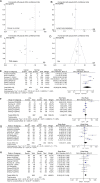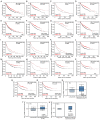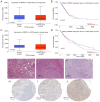Prognostic significance of SPARC expression in non-small cell lung cancer: A meta-analysis and bioinformatics analysis
- PMID: 36245823
- PMCID: PMC9557165
- DOI: 10.3892/ol.2022.13532
Prognostic significance of SPARC expression in non-small cell lung cancer: A meta-analysis and bioinformatics analysis
Abstract
The aim of the present study was to elucidate the significance of secreted protein acidic and cysteine rich (SPARC) expression in non-small cell lung cancer (NSCLC) in terms of clinicopathology, immune-cell infiltration and survival prognosis. A meta-analysis and bioinformatics analysis were performed using studies retrieved with PubMed, Web of Science, Wanfang Data and the Chinese National Knowledge Infrastructure databases. The meta-analysis suggested that, compared with normal tissues, SPARC expression was elevated in NSCLC tissues. The expression of SPARC was not significantly associated with TNM stage and lymph-node metastasis, and was positively associated with patient gender. Regarding the differential expression of SPARC and the relationship between expression levels and survival, the Oncomine database was consulted and Kaplan-Meier curves were drawn. It was indicated that SPARC mRNA expression levels were higher in NSCLC tissues than in normal tissues. Low expression of SPARC mRNA was negatively associated with overall survival, first progression survival and post-progression survival of patients. Further exploration of the relationship between SPARC expression and survival by univariate analysis indicated that TNM stage, lymph node metastasis, distant metastasis and depth of infiltration of lung cancer were negatively associated with patient prognosis. Cox multifactorial analysis suggested that SPARC expression levels and TNM stage were risk factors significantly affecting the prognosis of patients with NSCLC. Analysis with the GEPIA and UALCAN databases further indicated that the mRNA expression level of SPARC in lung adenocarcinoma (LUAD) and lung squamous cell carcinoma (LUSC) was higher than that in normal lung tissue, and the SPARC expression levels were affected by factors such as the TNM stage of lung cancer. A lower the level of SPARC mRNA expression was associated with a better relative survival prognosis of patients. In the Human Protein Atlas database, the expression level of SPARC protein was higher in LUAD and LUSC than in normal lung tissue. In the Timer database, the expression level of SPARC was closely linked to immune cells related to the occurrence of lung cancer, and the degree of immune-cell infiltration and SPARC protein expression were closely related to the prognosis of patients with lung cancer. Immune cells were indicated to exhibit significant inhibition of DNA proliferation mutation mechanisms in lung cancer (P<0.05). In summary, SPARC expression may be used as a valuable indicator of prognosis in patients with NSCLC, which may provide new approaches for preventative treatment.
Keywords: SPARC; bioinformatics analysis; meta-analysis; non-small cell lung cancer; prognosis.
Copyright: © Ma et al.
Conflict of interest statement
The authors declare that they have no competing interests.
Figures







Similar articles
-
Clinicopathological and prognostic significance of SPARC expression in gastric cancer: A meta‑analysis and bioinformatics analysis.Oncol Lett. 2023 Apr 20;25(6):240. doi: 10.3892/ol.2023.13826. eCollection 2023 Jun. Oncol Lett. 2023. PMID: 37181948 Free PMC article.
-
Prognostic Significance of SPARC Expression in Breast Cancer: A Meta-Analysis and Bioinformatics Analysis.Biomed Res Int. 2022 Feb 15;2022:8600419. doi: 10.1155/2022/8600419. eCollection 2022. Biomed Res Int. 2022. PMID: 35211625 Free PMC article. Review.
-
LINC00628 is differentially expressed between lung adenocarcinoma and squamous cell carcinoma and is associated with the prognosis of NSCLC.Oncol Lett. 2022 Feb;23(2):55. doi: 10.3892/ol.2021.13173. Epub 2021 Dec 21. Oncol Lett. 2022. PMID: 34992687 Free PMC article.
-
Validation and analysis of expression, prognosis and immune infiltration of WNT gene family in non-small cell lung cancer.Front Oncol. 2022 Jul 25;12:911316. doi: 10.3389/fonc.2022.911316. eCollection 2022. Front Oncol. 2022. PMID: 35957916 Free PMC article.
-
The Effect of GLUT1 on the Survival Rate and Immune Cell Infiltration of Lung Adenocarcinoma and Squamous Cell Carcinoma: A Meta and Bioinformatics Analysis.Anticancer Agents Med Chem. 2022;22(2):223-238. doi: 10.2174/1871520621666210708115406. Anticancer Agents Med Chem. 2022. PMID: 34238200 Review.
Cited by
-
Immunohistochemical expression of SPARC in odontogenic keratocysts: a comparative study with other odontogenic cysts.BMC Oral Health. 2024 Feb 12;24(1):223. doi: 10.1186/s12903-024-03978-4. BMC Oral Health. 2024. PMID: 38347494 Free PMC article.
-
Construction of EMT related prognostic signature for kidney renal clear cell carcinoma, through integrating bulk and single-cell gene expression profiles.Front Pharmacol. 2023 Nov 15;14:1302142. doi: 10.3389/fphar.2023.1302142. eCollection 2023. Front Pharmacol. 2023. PMID: 38035023 Free PMC article.
-
SPARC: a potential target for functional nanomaterials and drugs.Front Mol Biosci. 2023 Jul 28;10:1235428. doi: 10.3389/fmolb.2023.1235428. eCollection 2023. Front Mol Biosci. 2023. PMID: 37577749 Free PMC article. Review.
References
-
- Zhang F, Zhang Y, Da J, Jia Z, Wu H, Gu K. Downregulation of SPARC expression decreases cell migration and invasion involving epithelial-mesenchymal transition through the p-FAK/p-ERK pathway in esophageal squamous cell carcinoma. J Cancer. 2020;11:414–420. doi: 10.7150/jca.31427. - DOI - PMC - PubMed
LinkOut - more resources
Full Text Sources
Miscellaneous
